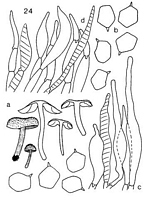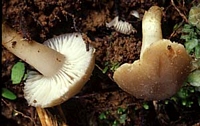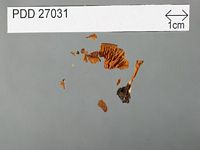|
 Entoloma vulsum Entoloma vulsum
BiostatusPresent in region - Indigenous. Endemic
Images (click to enlarge)
Caption: Entoloma vulsum Hk. (holotype):
a. carpophores. b. spores. c. cheilocystidia. d. cuticle. | 
Caption: Entoloma vulsum
Owner: Kaimai Bush | 
Caption: Dried type specimen
Owner: Herb PDD |
Article: Horak, E. (1973). Fungi Agaricini Novazelandiae I-V. Beihefte zur Nova Hedwigia 43: 200 p.
Description: Pileus
10-40 mm diam., hemispherical at first becoming convex or pulvinate, often plane
or depressed at the centre, sometimes even concave, soot-brown like Lactarius
fuliginosus, fading around the centre, dry, neither hygrophanous nor striate.
Lamellae broadly adnate or emarginate and decurrent with a short tooth, whitish-beige
turning grey-beige-pink, gill edge concolorous and fimbriate, moderately crowded.
Stipe 15-50 x 1.5-4 mm, cylindrical, straight, coloured like pileus, with white
weft near the base, totally covered by fibrils, at the apex occasionally pruinose,
dry, fistulose, single. Context white, brown in the cortex of pileus and stipe.
Odor and taste not distinctive.
Spores
7-9 x 6.5-7.5 µm, 5-6-sided. Basidia 30-40 x 8-12 µm, 4-spored. Cheilocystidia
45-100 x 8-12 µm, lageniform or fusoid, hyaline, rarely coloured by brown plasmatic
pigment. Pleuro- and caulocystidia none or like cheilocystidia, scattered. Cuticle
a palisade of erect, fusoid or awl-shaped cells (40-140 x 6-20 µm), membrane
hyaline, thin-walled, with brown plasmatic pigment. Clamp connections present
or absent
Habitat: On soil in forests (under Nothofagus
spp., Podocarpus spp., Dacrydium cupressinum, Quintinia spp.,
etc.). New Zealand.
Notes: This
species is characterised by its velvety, soot-brown pileus and the palisadic
structure of the cuticle, which is similar to that found in several species
of the genus Pluteus Fr. (sect. Hispidodermi). In colour and structure the surface
of the pileus on fully developed fruitbodies as seen from above is strongly
reminiscent of Lactarius fuliginosus Fr.
|